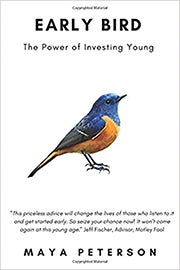Minnesota teen writes book about how to invest money; Girl, 15, started building her stock portfolio at age 9
Published 8:30 am Monday, December 11, 2017
By Mary Divine
St. Paul Pioneer Press
ST. PAUL (AP) — It all started with an American girl and her American Girl.
Six years ago, stock whiz Maya Peterson sold her American Girl doll for $100. She used the money to buy shares in Mattel, the toy company that manufactures the dolls.
She was 9 years old.
“I made a huge mistake with that one because Mattel stock has plummeted,” Maya Peterson told the Pioneer Press . “I think it’s at $18 right now, and I bought it at $35. I still have it.”
Maya Peterson, 15, of St. Paul, has expanded her stock portfolio over the past six years. Among her current holdings: Johnson & Johnson, Pepsi, Berkshire Hathaway, Nestle and Gilead Sciences.
She recently wrote a book called “Early Bird: The Power of Investing Young,” which was published last month by Amazon.
“The whole purpose of the book is to really make investing more accessible and make it just seem easy and fun, which it is,” Maya Peterson said. “It’s not really a hard concept once you get used to it.”
Maya Peterson got into investing through her father, Gunnar Peterson, who designs software systems. On the drive to and from ballet practice, the two would listen to the “Motley Foolery” podcast, she said.
Before Maya Peterson could buy any stocks, however, she had to read “Growing Money: A Complete Investing Guide for Kids” by Gail Karlitz.
“I was told I had to read a chapter a week before I was allowed to start investing,” she said. “That’s where I was first introduced to the concept of compounding, and that’s what really got me started.”
Maya invests in products she knows and understands. Take Pepsi, for example.
“The cool thing about Pepsi is that they actually make more money with their chips than their drinks, which I never knew,” she said. “I picked Pepsi because I love Sun Chips. Cheddar Sun Chips are my favorite — that’s how I pick most of my stocks.”
When she was 10, Maya wrote a blog post for the Motley Fool Stock Advisor website explaining “why Mattel was a better stock pick than Hasbro,” she said. (Now Hasbro, which was trading at around $92 Friday, is rumored to be considering a takeover of Mattel).
That same year, she and her father began attending the Berkshire Hathaway annual shareholders meeting in Omaha, Nebraska; they haven’t missed a meeting since.
“We stand in the line every year at 4:30 in the morning and wait for the doors to open at 8:30, and then get to go and sit and watch Warren Buffett and Charlie Munger speak all day,” she said.
In 2013, Maya, then age 11, was the youngest person ever to apply and be accepted to attend the Motley Fool’s “College Women and Investing” conference.
By the time she was 14, Maya had another first to add to her resume: the first female to present to Google’s investing club at the company’s headquarters in Mountain View, California.
Maya started her own investment blog called “Compounding Snowballs” in 2016.
The title comes from her favorite investor, Warren Buffett, the CEO and chairman of Berkshire Hathaway, who said: “Life is like a snowball. The important thing is finding wet snow and a really long hill.”
Berkshire Hathaway is one of her favorite stocks, she said, because it’s “a safe company, and it’s run by a huge investor who knows what he’s doing.”
Buffett “invests in a whole bunch of companies that you can relate to and are consumer staples — things that aren’t going to go anywhere anytime soon,” Maya said. “He just helped me figure out where I wanted to go because I can relate to his mindset when it comes to investing.”
Maya, a freshman at Mounds Park Academy, applied for a summer internship at the Motley Fool. They turned her down “because (she) was in eighth grade,” Maya said, but invited her to consult via videoconferencing once a week with a team of investors on their “Fools in Schools” initiative focused on getting teens to invest.
In her spare time over the summer, Maya Peterson decided to write her book. She said she saw a need for an investment book for people between the ages of 12 and 25 written by another young person.
 Maya recommends that young investors begin by looking around their house for products produced by companies that might be good investments.
Maya recommends that young investors begin by looking around their house for products produced by companies that might be good investments.
“Who sells those light bulbs? Everyone uses light bulbs,” she said.
Maya Peterson wrote in her book about buying bought Johnson & Johnson stock four years ago.
“I bought Johnson & Johnson because I’m a dancer and I would use their toe tape on a daily basis,” she said. “I went through about one roll a week, meaning over 52 weeks at a cost of $3.99, they made $207.48 from one customer and one product by the end of the year.”
She said she has made $160 so far on that investment.
Maya interviewed a number of investors for the book, including David Gardner, one of the founders of Motley Fool.
Gardner told Maya Peterson that good investors are like sports fans. “They are going to be a fan whether their team wins or loses that day,” he told her. “(Good investors are not) going to sell their stock whether or not it goes up or down, today, this week or even this year because they’re in it to win it over the only term that counts, which is the long term.”
Maya, a Boston Red Sox fan, continues the analogy in her book: “When your team makes a mistake, you stick with them,” she writes. “Just because the Red Sox lose a game or two doesn’t mean you are suddenly a Yankees fan.”
Maya and her parents have worked out a deal: Any money that Maya invests in the stock market, they will match dollar-for-dollar.
“It’s very generous of them,” Maya said. “The nice thing about investing is that money will grow no matter how much you put in. If you just get the right stock, it will hopefully compound over time, so if you put in $100, and it’s a really good stock, like Berkshire Hathaway, it’s hopefully going to rise and do well.”
Because she is a minor, the Petersons bought the stocks and hold them for Maya.
One of her latest purchases is Gilead Sciences, a bio-tech company that recently purchased Kite Pharma — “KITE is their ticker symbol,” she said — which produces cancer treatments that train a patient’s immune cells to attack tumors.
She likes the stock so much, in fact, that she recently bought a share for her mother as a birthday present.





